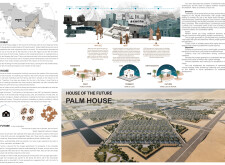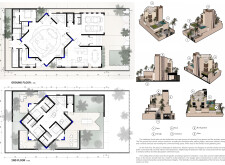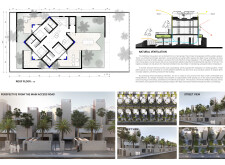5 key facts about this project
**Overview**
Located in Dubai, United Arab Emirates, the Palm House project represents a contemporary architectural response to the region's climatic challenges while honoring its cultural heritage. This design integrates traditional Emirati elements with modern sustainable practices, reflecting a commitment to enhance human habitation in alignment with environmental conditions and community values. The project seeks to create a living environment that embodies the significance of the date palm tree, a symbol deeply embedded in Emirati culture.
**Spatial Configuration**
The Palm House employs a multi-angled spatial arrangement that carefully balances communal living and individual privacy. Central to the layout is a multifunctional core that facilitates social interactions, surrounded by peripheral areas catering to private needs. The design distinguishes between primary family spaces and auxiliary areas, enabling flexibility for various activities from communal gatherings to personal retreats. This approach fosters a versatile living experience, conducive to a family's dynamic lifestyle while minimizing environmental impact.
**Materiality and Sustainability**
A thoughtful selection of materials underscores the Palm House’s commitment to sustainable design. By incorporating traditional mud and palm wood alongside modern concrete, lightweight blocks, and glass, the project creates a structure that is both culturally relevant and energy efficient. Features such as natural ventilation systems and green roof spaces enhance comfort and functionality, enabling effective temperature management in the desert climate. Additionally, the adaptive layout allows for future expansions, ensuring long-term sustainability as family needs evolve. This integration of materials and design principles promotes the creation of a sustainable microenvironment that resonates with local identity.






















































